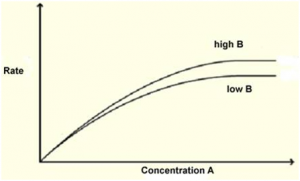The Concept of Limiting Factors and it’s Application to Skin Care

Concentration A is carbon dioxide. B is light intensity
The graph above describes most biological processes that depend on the supply of nutrients or substrates. I first encountered it as a student of photosynthesis, trying to understand how the effect of light intensity and the concentration of carbon dioxide affected the rate of photosynthesis of a leaf or an alga. In this graph, “A” would have been carbon dioxide and “B” light intensity. You can keep increasing carbon dioxide concentration but then you reach a plateau. At that point, more carbon dioxide will not change the rate of the process, you will have to increase light intensity.
Let’s use the graph to describe, for example, the division of skin cells, a process we want to promote in our aging skin.
Do the cells need glucose? OK, let’s give them glucose and division rate should increase…. but only up to a point, because when the cells have enough glucose, the division rate will stop increasing. Maybe what they need at this point is an amino acid, say, proline? Let’s add it. Division rate will increase but not “forever,” not proportionally to the addition of proline because as soon as there is enough proline, another nutrient will become “limiting.”
If you look at skin from this point of view, and we should because the skin is a biological system that responds in this way to the addition of nutrients, then the “magic ingredient” approach of most skin care companies looks like nonsense (and it is nonsense.) Even assuming that the kin of all the clients will be in need of the same nutrient, be it an amino acid, a sugar, a vitamin, whatever, it should be apparent that there is a certain amount of that ingredient that will benefit the skin and then something else, not the ingredient advertised as magic, will be required.
This is why SAS ingredient lists are so complex. For example, our Hair Care Serum contains Keratinocyte Growth Factor, a powerful growth factor that will signal the keratinocytes in the scalp that they should multiply and produce hair. In addition, you also need to provide the keratinocytes with the resources to do this job. This is where amino acids, sugars, vitamins and more are required, and so we provide them.
The complexity of biological processes is another reason why we focus each of our products on a particular problem or issue. But we also need to be attentive to the whole of the skin’s biology. What’s the point of killing acne bacteria with powerful oxidants when those oxidants will accelerate skin aging? Instead, we look at the whole picture and aim for long term results.
At Skin Actives we don’t follow the marketing myth machines by using the “ingredient of the month.” We only use actives that are proven to be effective in published scientific studies.
Dr. Hannah Sivak
